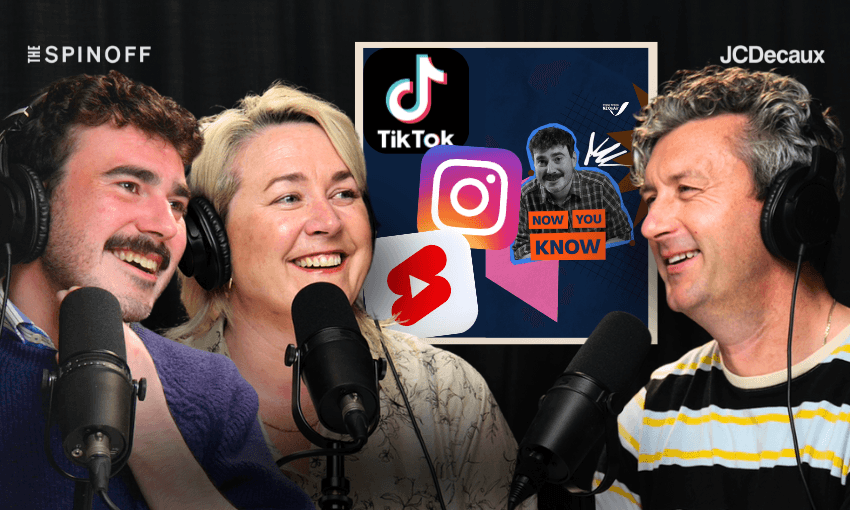The media industry is obsessed with finding ways to reach young people, often concluding that Gen Z is ‘fickle’ and unattainable. But The Spinoff’s social first explainer series, Now You Know, is proving otherwise.
With over 2.5 million views in just 10 weeks, Now You Know has captured the attention of 18-24 year-olds. Launched in July, the NZ On Air-funded series has tackled topics like boot camp trials, NCEA changes, recognition of Palestinian statehood, unemployment, big tech and government debt.
A new study from the Pew Research Center found that 43% of adults under the age of 30 in the US say they regularly get news on TikTok, up from 9% in 2020. This year’s Reuters Institute Digital News report presented a tipping point for news consumption behaviour among under-35s in the US. Over half (54% of 18–24s and 50% of 25–34s) now identify social media and video networks as their main source of news. As The Spinoff’s head of audience, Anna Rawhiti-Connell, wrote when the series launched, “it’s safe to assume these trends are being replicated here.”
On this week’s episode of The Fold, Duncan Greive sits down with Anna and Now You Know host Robbie Nicol to break down the highly successful strategy behind The Spinoff’s social-first news explainer series.
Anna and Robbie discuss the philosophy of treating young people as worthy news consumers, the intentional craft used to blend serious journalism with platform-native comedy, how the episodes get made, and the differences in distributing content across TikTok, Instagram and YouTube Shorts.
The following is an edited and condensed version of an episode of The Fold. Listen in full on Apple Podcasts, Spotify or wherever you listen to podcasts.
On why the gig appealed to Robbie and the importance of the host
Robbie Nicol: I grew up loving Jon Stewart and Stephen Colbert and started mimicking them with a series called White Man Behind A Desk, and have continued doing it ever since. When I saw a job being advertised at The Spinoff saying, “Hey, we’re gonna make a bunch of short form videos explaining the news to young people”, I thought, “I could do that. I could give that a go.” It was a very exciting moment.
Anna Rawhiti-Connell: We knew we needed a face. It’s a bit of borrowing from creator media. We wanted someone that people would relate to, who they could trust, and who would take on the role three times a week of explaining a big news item.
[Now You Know] is pastiche. Robbie brought a universe of stylistic film, television and social media references… and an understanding of what people react and respond to.
On not treating younger audiences as unattainable ‘exotic zoo animals’
RN: Young people don’t have short attention spans. They’ve got short consideration spans.
ARC: [Now You Know] was born of a desire to buck some of the generalisations around young people’s engagement with news. Just because they’re not reading it on a website doesn’t mean that they’re not engaging with it. I have read a lot recently around the fact that young people are willing to pay for news. It’s just format based. They trust a particular person or a creator, rather than an institution.
I tend to try and talk about people as a collection of interests, beliefs and values, rather than demographic information, like age.
The crucial blend of substance and style
Duncan Greive: I saw a presentation that you circulated earlier, and it talks about a golden ratio of number of jokes per minute. How do you balance “here are your vegetables and here’s some lollies”?
RN: I want people to know things and to understand I really care. But my background is also in writing comedy, so it just comes out that way.
Not all of our videos are funny. There are still rules that apply: storytelling, communicating and explaining to people why they should care because the issue matters. Humour is a really useful tool, but it’s not the only tool you can use to get people to watch a video.
I have learned that you can throw all the sparkle, glitter and showbiz onto something, and if they don’t care about the topic, then they won’t watch the video.
Balancing public interest journalism on algorithmic platforms
DG: There’s always this danger of being drawn into mercilessly following what the algorithm tells you to do. I think some of the art of Now You Know is “no, we’re going to try and do this really hard thing, and it might fail, but we have to try”. That’s the public media element of it.
RN: I think fundamentally people do have to care about the subject. We’re learning all of these skills to then apply them to things that people find “boring” and “uninteresting”, and then we will do our best to leverage as many views as we can possibly get for the thing that “nobody cares about”.
Listen in full on Apple Podcasts, Spotify or wherever you listen to podcasts.

